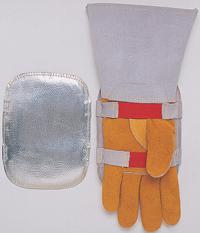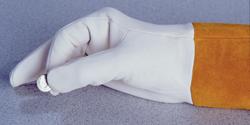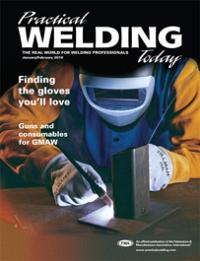- FMA
- The Fabricator
- FABTECH
- Canadian Metalworking
Categories
- Additive Manufacturing
- Aluminum Welding
- Arc Welding
- Assembly and Joining
- Automation and Robotics
- Bending and Forming
- Consumables
- Cutting and Weld Prep
- Electric Vehicles
- En Español
- Finishing
- Hydroforming
- Laser Cutting
- Laser Welding
- Machining
- Manufacturing Software
- Materials Handling
- Metals/Materials
- Oxyfuel Cutting
- Plasma Cutting
- Power Tools
- Punching and Other Holemaking
- Roll Forming
- Safety
- Sawing
- Shearing
- Shop Management
- Testing and Measuring
- Tube and Pipe Fabrication
- Tube and Pipe Production
- Waterjet Cutting
Industry Directory
Webcasts
Podcasts
FAB 40
Advertise
Subscribe
Account Login
Search
Love your gloves
Everything you wanted to know (but never asked) about welding gloves
- By Amanda Carlson
- January 14, 2010
- Article
- Safety

To get the best results from your welding gloves, it is imperative to match your process with the appropriate materials.
For many welders, pulling on a pair of welding gloves is second nature. What may not be second nature, however, is choosing the right glove to fit your needs of protection, comfort, and dexterity. Just as welding processes differ, so do the gloves that are best-suited for those processes.
Most of us can differentiate between a shielded metal arc welding (SMAW) glove and a gas tungsten arc welding (GTAW) glove just by looking at them. It gets a little tougher when choosing between a split-leather cowhide glove for gas metal arc welding (GMAW) and a top-grain pigskin glove for the same application. Generally speaking, each will protect your hands from heat. The question is will they protect you enough and provide you with other characteristics that will make you more comfortable? Bottom line, to get the level of protection, comfort, and dexterity that you want, you have to be able to match the glove with your welding process.
All Leather is Not Created Equal
Sure, you may already know that the best welding gloves are made of leather. But what you may not know is what the best leather is, where it comes from, and why it's best-suited for a particular application. Leather, whether it's from a cow, deer, elk, pig, or goat, is generally categorized as top-grain or split-leather.
Top-grain leather is the smoothest and strongest leather available, said Mark Williams, head of marketing for John Tillman Co., Compton, Calif. It tends to be the most durable and the most capable of withstanding wear and tear.
"Imagine the hide of a cow. When they take that hide off, the very top level is the top-grain," Williams said.
The next layer of leather underneath the top grain is what is called split leather, also referred to as suede. Split leather can come from either the side of the animal (side split) or the shoulder. Within the shoulder there are different grades: select shoulder, standard shoulder, and economy shoulder. Split leather tends to have a rougher surface compared to top-grain leather, but still provides good heat protection at an affordable cost.
SMAW
The Process:
Shielded metal arc welding produces the most heat, sparks, and spatter of all the welding processes. Therefore, gloves tailored for this process must address heat resistance not just with the leather, but also with the lining. At the same time, they must also maintain some level of dexterity.
The Glove:
Top-grain cowhide, top-grain pigskin, and top-grain elkskin are the best leathers for SMAW, with cowhide and split leathers as the most popular. Cowhide provides durability, while the pigskin provides a natural resistance to oil and water. Elkskin does not harden as quickly when exposed to heat.

For an extra layer of heat protection during SMAW, use an aluminized shield, which reflects heat from the arc away from your hand.
The gloves' priority is to first protect against heat, which sometimes can lead to a loss of dexterity. In other words, if you are looking for the same dexterity found in GTAW gloves, you're probably out of luck.
"No one has really figured out yet how to make a superthin glove with lots of heat insulation. Generally, the heavier the weight of the glove, the more it's going to protect you from the heat," Williams said.
Tip:
If you need more dexterity, Williams suggests trying a glove with a cotton lining instead of a cotton/foam or wool lining. It will not give you the heat resistance that, say, a wool lining would, but it will allow you to be more mobile while absorbing perspiration.
If your glove isn't giving you enough heat protection, Jay Swearingen, sales and marketing manager at Weldas, Franklin, Tenn., suggests adding an aluminized hand shield, which reflects away the radiant heat from the weld. Also, check to see if your glove is cotton-lined, also known as sock-lined. If so, try a glove lined with wool or cotton-foam for an added layer of heat resistance.
Look for gloves that are sewn with Kevlar® thread, which is both strong and heat-resistant.
"If you get a bit of molten spatter or a hot piece of metal in the seam, it can generally stick there. Typical cotton thread would burn out almost immediately. Kevlar thread is more resistant, making the glove a lot more durable," Swearingen said.
GMAW
The Process:
Gas metal arc welding is the most widely used welding process in manufacturing. It also happens to pose the widest variety of needs when it comes to welding gloves. The process generates a lot of heat, although not as much as SMAW, but requires slightly more dexterity than SMAW.
The Glove:

A glove for GTAW must provide you with ample heat resistance but still allow for intricate movements.
Swearingen said heat protection and comfort are the factors that most welders consider when choosing a glove.
"The types of gloves they are looking for are going to be thick and pliable with a thin lining, like a cotton sock, that will protect them from the heat, spark, and spatter, but also give them enough comfort and dexterity to allow them to move along the weld with little resistance from the glove," Swearingen said.
Top-grain cowhide, pigskin, and deerskin are the recommended leathers for GMAW. Top-grain deerskin provides a high level of comfort and has the ability to mold to the shape of your hands. A split-leather cowhide glove provides durability at a lower price point than a top-grain leather.
Tip:
If you're looking for a little more dexterity for light-duty GMAW applications, Williams suggests a top-grain goatskin glove with fleece lining, usually reserved for GTAW applications. The leather itself is thinner but provides excellent resistance to abrasions, even more so than cowhide, for its weight.
For other dexterity-related issues, Swearingen recommends trying gloves with different thumb styles. For example, a winged thumb, straight thumb, or a keystone thumb can make a big difference in getting that extra level of dexterity and comfort.
GTAW
The Process:
GTAW requires precision to move the torch and finesse to feed the filler rod into the puddle. While still a hot process, it does not emit as much heat as SMAW or GMAW and generates almost no spark or spatter.
The Glove:
Dexterity and feel are the most sought after qualities for GTAW gloves, said Williams. For hotter GTAW applications, choose a top-grain pigskin or top-grain kidskin/cowhide split glove. Both will provide you with excellent dexterity characteristics, and the kidskin/cowhide split provides the same soft feel at the palm while providing an extra layer of protection to the back of the hand.
Tip:
If you prefer a little resistance while feeding the filler rod, Williams suggests a deerskin split glove, which has a rougher surface but still provides a good amount of dexterity. This material is also the most comfortable.
About the Author

Amanda Carlson
2135 Point Blvd
Elgin, IL 60123
815-227-8260
Amanda Carlson was named as the editor for The WELDER in January 2017. She is responsible for coordinating and writing or editing all of the magazine’s editorial content. Before joining The WELDER, Amanda was a news editor for two years, coordinating and editing all product and industry news items for several publications and thefabricator.com.
About the Publication
subscribe now

The Welder, formerly known as Practical Welding Today, is a showcase of the real people who make the products we use and work with every day. This magazine has served the welding community in North America well for more than 20 years.
start your free subscription- Stay connected from anywhere

Easily access valuable industry resources now with full access to the digital edition of The Fabricator.

Easily access valuable industry resources now with full access to the digital edition of The Welder.

Easily access valuable industry resources now with full access to the digital edition of The Tube and Pipe Journal.
- Podcasting
- Podcast:
- The Fabricator Podcast
- Published:
- 04/16/2024
- Running Time:
- 63:29
In this episode of The Fabricator Podcast, Caleb Chamberlain, co-founder and CEO of OSH Cut, discusses his company’s...
- Industry Events
16th Annual Safety Conference
- April 30 - May 1, 2024
- Elgin,
Pipe and Tube Conference
- May 21 - 22, 2024
- Omaha, NE
World-Class Roll Forming Workshop
- June 5 - 6, 2024
- Louisville, KY
Advanced Laser Application Workshop
- June 25 - 27, 2024
- Novi, MI































